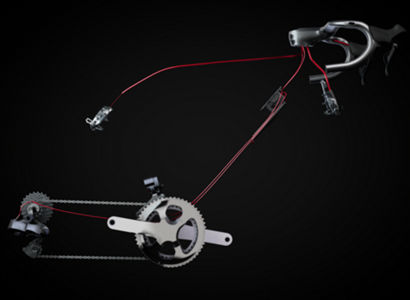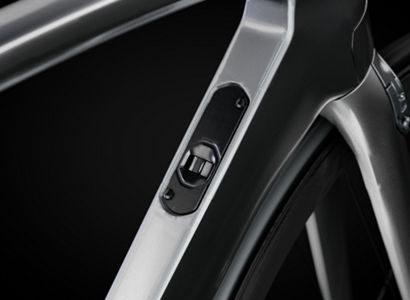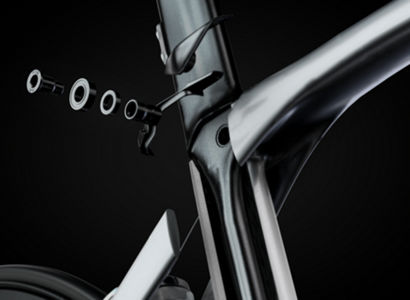Seven ways the new Madone is better than the old one
By Caley Fretz (velonews.com)The old Trek Madone, launched in 2013, was a frame born of compromise. It had rounder tube shapes than most of its competitors, designed to maintain ride quality while providing only modest aerodynamic benefit.
Its replacement is more purposeful. The all-new Madone is an aero bike, no apologies.
The new Madone features increased system integration — the handlebars, stem, and brakes are all proprietary now — as well as revised, more extreme tube shapes and the addition of an IsoSpeed decoupler, technology borrowed from the cobblestone-inspired Domane line.
 Trek claims the new Madone is more aerodynamic and more comfortable than its predecessor, with a stiffer fork for improved handling.
Trek claims the new Madone is more aerodynamic and more comfortable than its predecessor, with a stiffer fork for improved handling.According to Trek’s wind tunnel testing, the Madone is faster than the Giant Propel, Cervelo S5, and Felt AR. It was not tested against the brand-new Specialized Venge, or the old Venge, which Trek described as “not a leader in aerodynamics.”
If true, that’s a big step up from the old Madone, which, though aerodynamic, couldn’t touch bikes like the S5 or Propel in the wind tunnel. In fact, this new Madone seems to be a jump up from the old version in almost every way.
So how did Trek get there?
More shapely
Trek is a fan of the Kamm tail, a truncated version of traditional teardrop aero shapes. It allows engineers to control airflow while using wider, stiffer, and usually lighter tubes. The love of Kamm hasn’t changed, but the new Madone pushes the design further, with longer, more aerodynamic profiles, and mates it with traditional teardrop-shaped tubes in particular areas.

Hide everything
Hiding the cables and housing was clearly the design directive behind the new Madone. The engineering team at Trek managed to hide away every millimeter of cable from the brakes and front derailleur, with only a short length reaching out to the rear derailleur to remind riders that the levers are indeed connected to the derailleurs and brakes.
Integrated brakes
The brakes aren’t hidden, but they are proprietary and the front is tucked perfectly into the fork. Both front and rear brakes are center-pull (like an old Dia-Compe, but hopefully less terrible) with fully internal cables.
Each arm has an independent spring-tension adjustment to center the pads and adjust lever-pull force. The brakes also have two spacing screws to adjust for pad wear or different rim widths. These spacing screws allow riders to swap between rims with up to 6mm difference without adjusting the center wedge.
The brakes are not branded Bontrager — as Madone brakes have been in the past — but will be available in the Bontrager parts catalog. The mount is completely proprietary, so the availability of a third-party option is unlikely.
The front brake cables run down through the head tube. To allow the fork to turn, Trek engineered what it calls “Vector Wings” into the head tube. Essentially, there are two little doors on the front of the head tube that open up as the fork is turned, allowing the center-pull brake cable to rotate.
One-piece bar and stem
Complete cable integration required a bar/stem rethink. The two have been combined into a single unit, with cable routing through the bar and stem and into the headset.
In a nice touch for the home mechanic, Trek designed the proprietary headset spacers with a clamshell, so they can be added or removed without cutting cables and housing.
Simply hiding the cables and housing saved 40 grams of drag, according to Trek.
Control center
With all cables and housing hidden from view, Trek had to design a way to adjust them on the fly. The solution: the ‘control center,’ located on the top of the down tube, which houses a front derailleur trim dial on mechanical setups and a Di2 battery and junction box on electronic setups.
Careful bottle placement
Trek did most of its wind tunnel testing and subsequent real-world confirmation with two bottles on its frame, to better replicate real-world situations, it said.
The company put a lot of work into the placement of bottle cages inside the frame, studying 140 different iterations before settling on the final placement. The result, Trek says, is a 5.5 percent reduction in drag thanks only to the placement of the bottles. Sounds crazy, but in the marginal gains game of aerodynamics, it’s not beyond possibility.
Borrowing from endurance bikes
Comfort is an oft-ignored feature in the design of race bikes, but it shouldn’t be. Building a comfortable aero frame is made particularly difficult by the shape of aerodynamic tubes, which are usually much longer than they are wide. These narrow shapes act like an I-beam, resisting vertical flex that provides comfort.
Trek’s solution is to borrow technology from its endurance line, the Domane. The IsoSpeed decoupler is essentially a pivot (okay, ‘decoupler’) at the junction of the seat tube and top tube that allows the seat tube to flex independently of the rest of the frame. This provides noticeable vertical give and improves comfort dramatically. It’s now used on the Domane and Silque road bikes, as well as Trek’s new Procaliber hardtail mountain bike.
The Madone’s seat tube appears to be too wide to provide the forward/back flex that makes the decoupler effective. But there’s something hidden inside: tube inside the tube, designed to bend and flex vertically. The outer tube takes care of drivetrain stiffness and acts as a fairing for a rounder inner tube. The result is a significant increase in vertical compliance, visible simply by pressing on the back of the saddle.
We are located at 1038 W. 4th St in Ontario, CA.
You can reach us by phone at (909) 984-9067





No comments:
Post a Comment